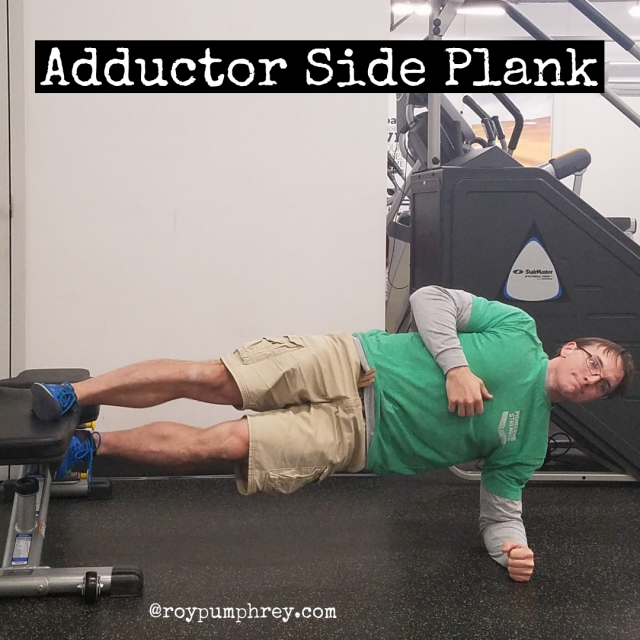
Adductors are The Forgotten Step Children Of Leg Musculature
We forget about them, don’t train them, let them fade and shrivel away.
until…..
POP, Goes the Groin…
Truth is, the hip adductor group:
- Adductor Magnus
- Adductor Longus
- Adductor Brevis
- Pectinius
- Gracilius
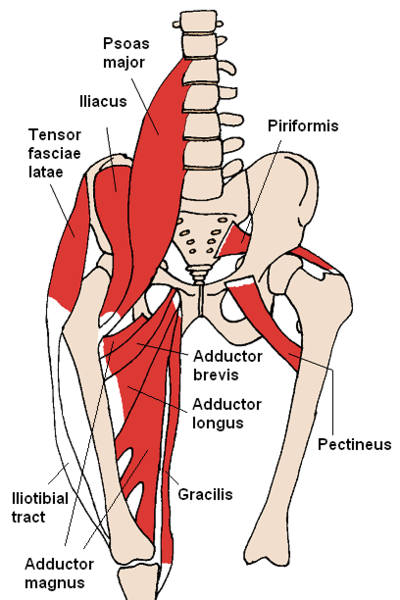
are kinda important. <—-they’re there for a reason.
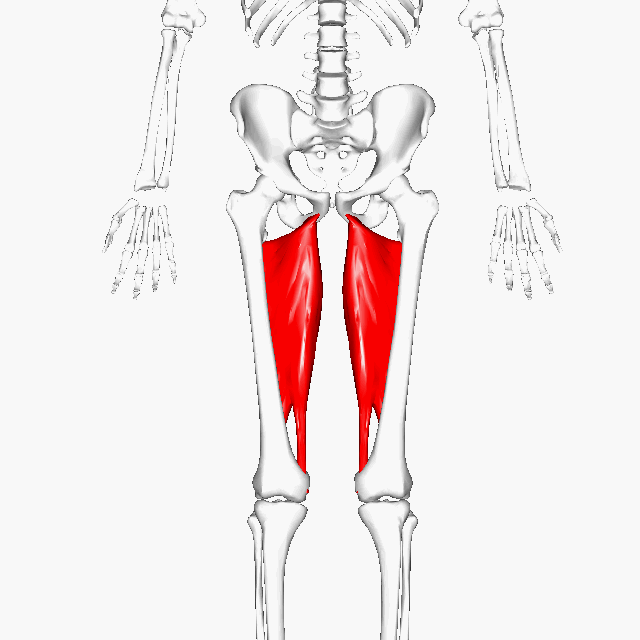
The red area is the Adductor Magnus…yeah, it’s a Magnus
What Do Hip Adductors Do?
This is what we used to know:
They adduct the femur…ie, bring the femur in towards the midline of the body.
Adductors internally rotate the femur….ie rotate the kneecap toward the midline (think, knock knees)
But Wait, There’s More!
Through #science we’ve figured out the hip adductor group does so much more.
The function just depends on the:
- Individual hip adductor muscle in question
- The position and action of the hip at that moment
“Cadaveric studies indicate that adductor magnus is structurally partitioned into at least two regions. The aim of this study was to investigate the direction-specific actions of proximal and distal portions of adductor magnus, and in doing so determine if these segments have distinct functional roles……This study suggests that adductor magnus has at least two functionally unique regions. Differences were most evident during rotation. The different direction-specific actions may imply that each segment performs separate roles in hip stability and movement.” – Benn, Pizzari and super friends
What’s That Mean in the Real World?
It means you’re going to use your long forgotten, neglected and undertrained hip adductors even if you don’t know it.
“One of the unique anatomical features of the adductor muscles as a group is that their function in the sagittal and transverse planes is dependent on the starting joint position. If the hip is flexed, then some portion of the adductor group will create extension. If the hip is extended, then another portion will create flexion. This occurs in every walking cycle. As the front leg goes through flexion, the adductors will decelerate the flexion and then create extension (along with many other muscles). But at this same time, the back leg is going through hip extension. The adductors on that side will help slow down this motion (along with the hip flexors) and then actually help create the hip flexion occurring during the forward swing of the leg. This same type of position-dependent function occurs in the transverse plane, as the adductors can function as internal or external rotators.” – Dr. David Tiberio
The Adductors Play A HUGE Role in Athletic Movement:
Especially in sprinting and cutting sports…<—which is just about all sports
“the amount of hip flexion present determines whether or not some of the adductors work on the femur as medial or lateral rotators and extensors or flexors (2). As odd as it may sound, the adductors are important as both hip flexors and extensors during the sprinting motion (3,4). Depending on the individual, the shift from flexor to extensor role occurs between 50 and 70 degrees of hip flexion. This phenomenon is possible due to the distal insertion point on the femur. When the hip is extended, the adductors’ line of pull is anterior to the hip joint axis, whereas this line of pull is posterior to the axis when the hip is flexed (2). –Cressey via T-Nation
Undertrained, weak adductors are especially at risk in sports that require aggressive change of direction like soccer and hockey.
“Ice hockey and soccer players seem particularly susceptible to adductor muscle strains. In professional ice hockey and soccer players throughout the world, approximately 10% to 11% of all injuries are groin strains. These injuries have been linked to hip muscle weakness, a previous injury to that area, preseason practice sessions, and level of experience. This injury may be prevented if these risk factors are addressed before each season.” – Groin Injuries in Sports Medicine
A pulled “groin” (adductor) can be just as debilitating and nagging for a weekend warrior as it is an athlete.
What to Do, What To Do?
Adductor Side Plank
Wait, All This Lead up For a Side Plank?
If you haven’t figured this out yet, the HIP Adductors have a HUGE role in Pelvic stability.
Plus,
“You can Never Have Too Much Ass, Abs and Upperback”
Adductor Side Plank
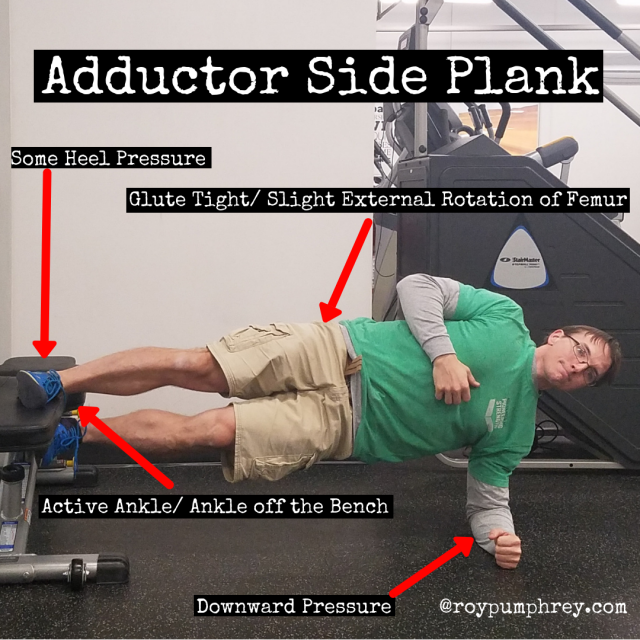 Checklist:
Checklist:
- Foot up on bench
- ACTIVE, STIFF ANKLE
- Glutes Tight
- Slight bend in the top knee
- Shoulder packed, elbow directly under the shoulders (centered in joint)
- Pressure through WHOLE forearm
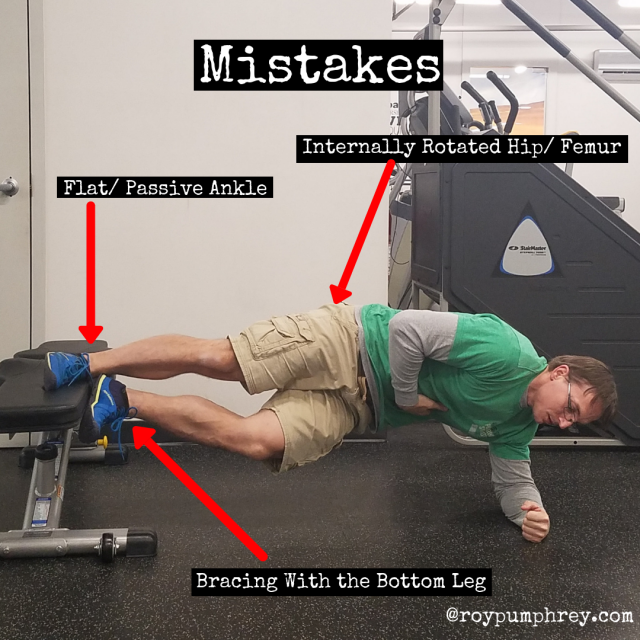
Bro Tips:
- If your ankle is touching the bench, you’re being passive. Tighten that up.
- If your knee hurts your probably doing some of these:
- Loose/ passive ankles
- Locked knees
- Internally rotate hips
- Internally rotated femur (knee cap on the bench)
- Not activating the glutes
- Press on the floor with the forearm
- TENSION over time
As you progress, don’t focus on adding time, try actively using the hip adductors to drive down into the bench.
Think about using the leg as a door with the hip (head of the femur) being the hinge.
Close the door down on the bench from the hinge (hip).



that looks extremely difficult
Ivy,
these are pretty difficult, but if you can do a good side plank and have good leg strength you should be ok. Short sets to start, 3-5 seconds is enough.
Thanks for reading.